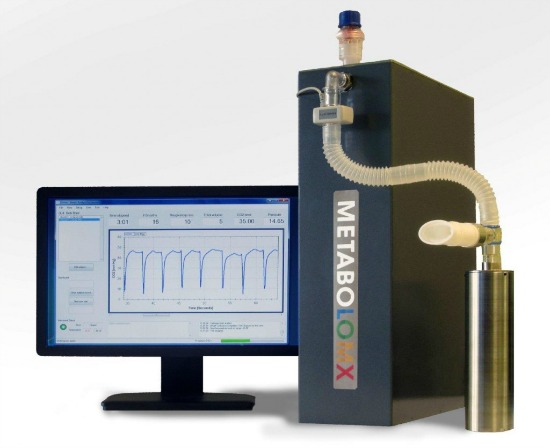These Machines Will Be Able to Detect Smells Your Own Nose Cannot
We’re getting closer to the day when your smartphone knows you have a cold before you do
![]()

A machine that sniffs out cancer. Photo courtesy of Metabolomx
Admittedly, it’s a little hard to imagine smell scientists, but research published earlier this week has those who study the sense of smell taking sides.
It comes down to how our noses detect odors. The long-standing explanation is that our noses have receptors that respond based on the shapes of odor molecules. Different molecules fit together with different receptors, the thinking goes, and when a match is made, the receptor tips off the brain that our nose has picked up a whiff of coffee or perhaps a very different smell emanating from the bottom of our shoe.
But a conflicting and more exotic theory received a boost in the new study by researchers in Greece. It holds that we can also sense smells through quantum physics, in this case the vibration of odor molecules. As Mark Anderson posits at Scientific American, “Does the nose, in other words, read off the chemical makeup of a mystery odorant—say, a waft of perfume or the aroma of wilted lettuce—by ‘ringing’ it like a bell?”
I know what you’re thinking: What difference does this make as long as I can still smell bacon?
Sniffing out trouble
But actually it does matter, because the more we understand the process of smelling, the more effective we can be at recreating it in machines. In fact, just last month IBM, in its annual “5 in 5″ forecast–a list of technologies it believes will hit the mainstream in five years–focused exclusively on the development of the five human senses in machines.
To mimic smelling, tiny sensors would be integrated into smartphones or other mobile devices and, as a breathalyzer can determine alcohol levels, they would gather data from the smell of your breath by detecting chemicals that humans wouldn’t perceive and send it to a computer in your doctor’s office. The thinking is that eventually this would be a core component of home health care–the ability to “smell” diseases remotely, such as liver or kidney ailments, asthma or diabetes.
Or on a more basic level, as IBM’s Hendrik Hamann put it: “Your phone might know you have a cold before you do.”
IBM is also working with health care organizations to equip patient and operating rooms with sensors that can help address one of the biggest problems hospitals face today–how do you keep them hygienic? Hundreds of sensors will basically sniff for cleanliness, identifying the chemical compounds that create odors, some of which are undetectable by humans. The staff can say they cleaned a room; the sensors will know if and when they did.
Every breath you take
The smell tests might even detect cancer. Last fall, in a study in the Journal of Thoracic Oncology, researchers from Israel and Colorado reported that breath analysis could distinguish between benign and malignant lung tumors with 88 percent accuracy. Plus, the breath test could determine the specific type and stage of the lung cancers.
And at the Cleveland Clinic, Dr. Peter Mazzone, director of the lung cancer program, is testing a sensor array that changes color when a patient’s breath passes over it. In a study of 229 patients, the test, using a machine developed by the California firm Metabolomx, was able to distinguish those with lung cancer with more than 80 percent accuracy.
Meanwhile, Mazzone and his team are collecting as many breath samples as possible from patients, both with and without lung cancer. The goal is match breath patterns with physical conditions. “My vision,” Mazzone told the Wall Street Journal, “is being able to say, ‘This is a 60-year old with emphysema who smoked for 30 years—what’s the chance of there being cancer there?’ But we have to teach the device what it looks like first.”
Or, perhaps more accurately, what it smells like.
Smell tests
Here are other recent discoveries scientists have made about smell:
- Me, my smell and I: Research in Germany concluded that not only can we identify our own body odor, but that we prefer it. For the study, women were asked to select which of their armpit odors they liked more. They showed a clear preference for the one perfumed with a solution that included elements of their own scent.
- Can robots wear Axe?: The U.S. Navy is looking to use scent-sniffing robots to move 1,000-pound bombs on ships. The idea is that a human would control the lead robot and it would dispense the equivalent of a robot pheromone that a swarm of other robots would follow like army ants.
- I love the smell of gridlock in the morning: When people are anxious, their sense of smell becomes more acute, according to a recent study at the University of Wisconsin-Madison.
- Why your dog can sniff out a chicken leg from a block away: And from the University of Chicago comes research finding that animals are able to focus their sense of smell much like humans can focus our eyes. Through their finely-honed sniffing techniques, they apparently can bring scents to receptors in different parts of the nose.
- There’s the rub: And finally, a study in the U.K. has found that thanks to a genetic variation, two percent of the population never has underarm body odor. Yet more than three-quarters of them still use deodorant because, well, that’s what people do.
Video bonus: Stuart Firestein, chairman of the biology department at Columbia University, tells you all you want to know about how our nose does its job.
Video bonus bonus: A Chinese airline that checks out the armpit odors of people interviewing to be pilots.
More from Smithsonian.com
Design Scent: An Olfactory Exhibition at the Museum of Art and Design
/https://tf-cmsv2-smithsonianmag-media.s3.amazonaws.com/accounts/headshot/randy-rieland-240.png)
/https://tf-cmsv2-smithsonianmag-media.s3.amazonaws.com/accounts/headshot/randy-rieland-240.png)